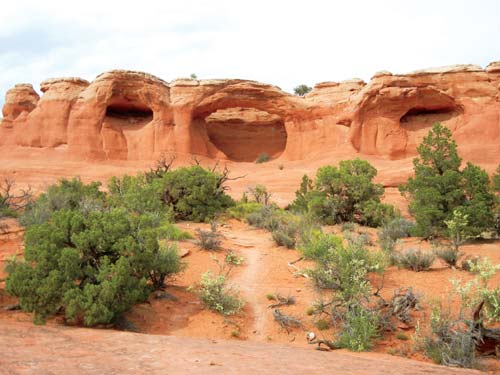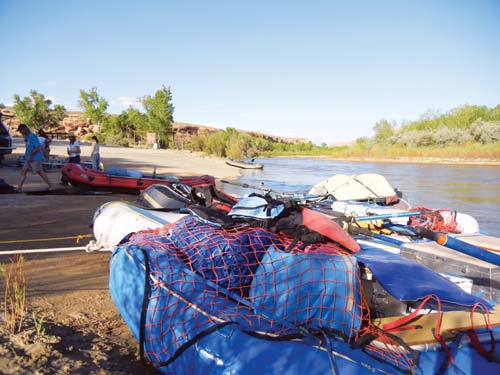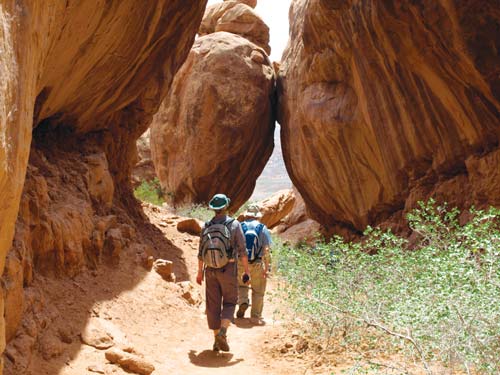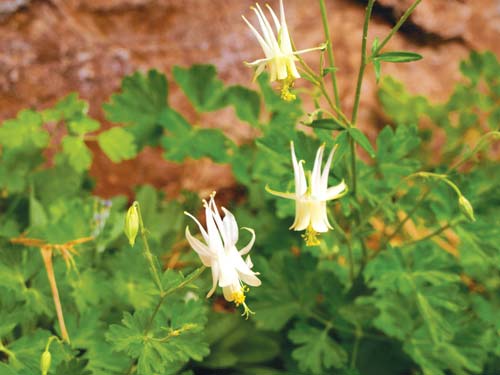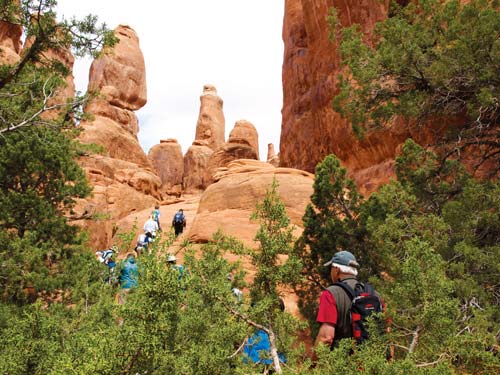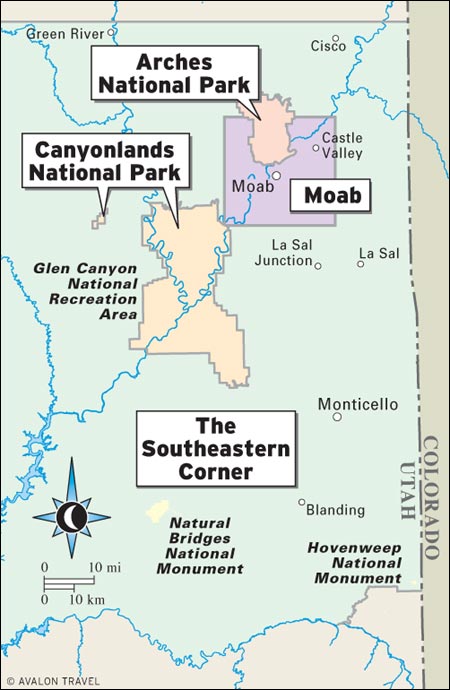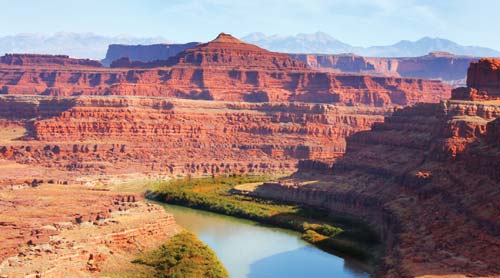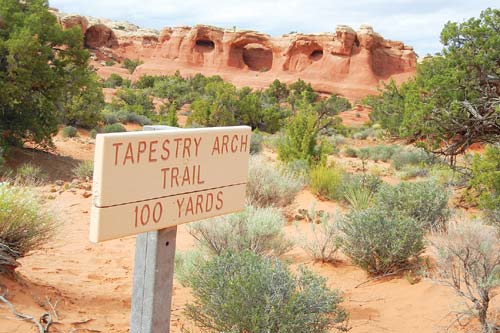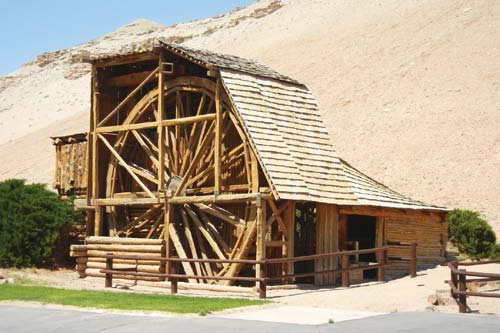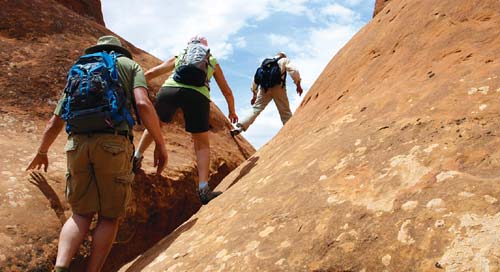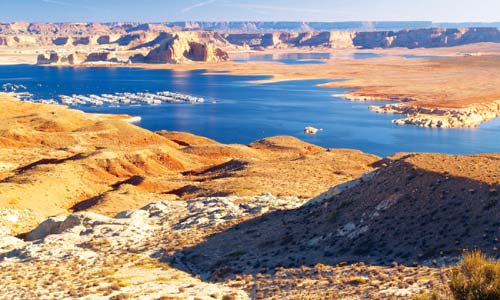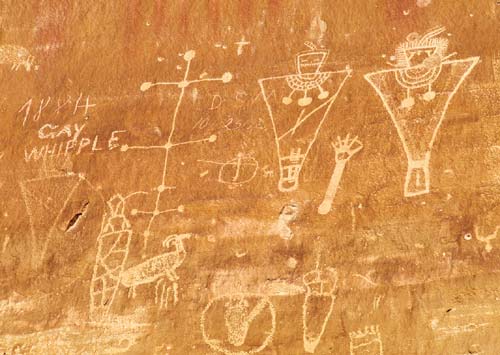Planning Your Trip
IF YOU HAVE . . .
Explore Arches & Canyonlands
THE BEST OF ARCHES AND CANYONLANDS
BEST DAY HIKES
BEST BIKE RIDES
RIVER TRIPS
THE LEGACY OF ANCIENT ROCK ART
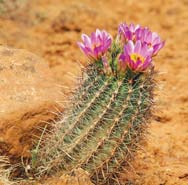 Southeastern Utah is so filled with staggering beauty, drama, and power that it seems like a place of myth. In this corner of Utah, two national parks, several national monuments and recreation areas, and multiple state parks are all within a day’s drive of each other. The colorful canyons, arches, and mesas found within this high, dry area are surprisingly diverse, and each park has its own characteristic landscape. Nor are the riches here restricted to natural beauty: These rugged landscapes hold the remains of ancient Native American cultures, and the haunting beauty of their rock art is on display at hundreds of locations. The area’s modern hub, and one of Utah’s most vibrant communities, is Moab, a recreational mecca known for its mountain biking and comfortable, even sophisticated, dining and lodging.
Southeastern Utah is so filled with staggering beauty, drama, and power that it seems like a place of myth. In this corner of Utah, two national parks, several national monuments and recreation areas, and multiple state parks are all within a day’s drive of each other. The colorful canyons, arches, and mesas found within this high, dry area are surprisingly diverse, and each park has its own characteristic landscape. Nor are the riches here restricted to natural beauty: These rugged landscapes hold the remains of ancient Native American cultures, and the haunting beauty of their rock art is on display at hundreds of locations. The area’s modern hub, and one of Utah’s most vibrant communities, is Moab, a recreational mecca known for its mountain biking and comfortable, even sophisticated, dining and lodging.
The mystical beauty of Arches National Park, where delicate rock arches provide vast windows into the solid rock, is awe-inspiring and nearly magical. Short trails draw hikers into a dramatic landscape of slickrock promontories and stone bridges.
In Canyonlands National Park, the Colorado River carves through deep red sandstone. From the Island in the Sky unit, expansive vistas take in hundreds of miles of canyon country, while rafting the Colorado’s Cataract Canyon is the wet and thrilling climax of many a vacation.
Beyond the national park boundaries, much of the land in southeastern Utah is publicly owned, and in many cases it vies with the national parks in terms of beauty and grandeur. No trip to Island in the Sky should neglect a side trip to Dead Horse State Park, with its astonishing views into the Colorado River Canyon. Hikers looking for their own patch of wildlands should check out Fisher Towers, a Bureau of Land Management recreation area upriver from Moab. A bit off the beaten path, Hovenweep National Monument preserves a wondrous series of Anasazi villages perched on the edge of a cliff—and best of all, you’ll often have the entire area to yourself.
Although many people first visit southeastern Utah as part of a grand tour of the Southwest, they often return here to further explore a smaller and distinctive corner of this vast landscape. After a small glimpse of the magnificence and variety, some latch on to one special place and return year after year, growing to know it intimately.
WHERE TO GO
Southeastern Utah encompasses some of the grandest landscapes on earth, including the first trenchings of the Colorado River’s Grand Canyon, the improbably elegant stone bridges of Arches National Park, a wealth of ancient rock art, and hiking and biking paths renowned around the globe—all in an area roughly the size of West Virginia. Nearly all the sites in this guide are just a day’s drive apart, so come with a week’s vacation and catch an eyeful of astonishing natural beauty, explore ancient Native American culture, and partake of recreational high energy in such youthful hotbeds as Moab.
Arches National Park
Arches National Park, with its famous rock bridges, is a great family park: It’s not too large, and there are lots of accessible hikes to explore. Unlike other Utah national parks, there’s plenty to see even if you can’t get out of the car and hike; the drive through the park is astonishing. But if you’re up for it, take along comfortable shoes and hike the Windows Section, a series of arches and rock fins at the center of the park, and to Delicate Arch, overlooking the Colorado River. You’ll need a permit (or better yet, join a ranger-led tour) and to be in good shape for the more challenging hikes into the remote and wonderful Fiery Furnace.
Canyonlands National Park
Canyonlands National Park comprises four sections: the River District, containing the canyons of the Colorado and Green Rivers; the Needles District, with hiking trails and backcountry roads through a standing-rock desert; the Maze District, a remote area filled with geologic curiosities and labyrinthine canyons; and the Island in the Sky District, a flat-topped mesa that overlooks all the rest. A separate area, the Horseshoe Canyon Unit, lies to the west and contains a significant cache of prehistoric rock art.
Moab
At the heart of Utah’s slickrock country, Moab is the recreation capital of southeastern Utah. Although mountain biking put Moab on the map, nowadays four-wheeling seems to be the extreme sport of choice. Arches National Park is just minutes from downtown, and Canyonlands’ districts are an easy drive from Moab. But Moab is a destination in itself, a youthful high-energy town that offers good restaurants, brewpubs, and coffee shops.
The Southeastern Corner
Although Arches and Canyonlands parks get most of the attention from first-time visitors, veterans of the area know that southeastern Utah has abundant other wonders in national recreation areas, national monuments, and state parks. After you have explored the national parks, be sure to save time to visit such fascinating destinations as Natural Bridges National Monument, Hovenweep National Monument, Dead Horse Point State Park, and the lovely alpine glades of La Sal National Forest.
WHEN TO GO
The parks are all open year-round, although spring (Apr.-early June) and early fall (Sept.-Oct.) are the most pleasant times to visit. They’re also the busiest, and travelers may find that popular campgrounds and hotels are booked well in advance.
Spring rain can also dampen trails, and late winter and early spring storms can play havoc with backcountry roads.
Thunderstorms are fairly common in summer (late July-early Sept.) and bring the threat of flash flooding, especially in slot canyons. In Canyonlands, Arches, and Moab, summer temperatures can reach the 100s.
In Canyonlands and Arches, winter days tend to be bright and sunny, but nighttime temperatures can dip into the teens or lower. However, the lack of crowds and brilliant sunshine can make this a wonderful time to visit, if you don’t mind layering your outer wear.
red rock formations in Canyonlands National Park
BEFORE YOU GO
Although the national parks and public lands of southeast Utah are located in a geographically compact area, connecting the dots to visit each of them isn’t always straightforward. The rugged topography of the area has made road building difficult, so visiting all of the areas we recommend requires planning ahead and making choices. Unpaved back roads can serve as shortcuts if you have a high-clearance vehicle, but check locally before setting out to determine current conditions: Rainstorms and snowmelt can render these roads impassable.
If you’re planning on making the rounds of all of Utah’s national parks, buy an America the Beautiful—National Parks and Federal Recreational Lands Pass ($80, good for one year) at your first stop to cover entrance to all national parks. If you plan to visit Hovenweep and Natural Bridges National Monuments as well as Arches and Canyonlands, pick up a Local Passport ($25, good for one year). Senior passes ($10 for a lifetime pass) and free passes for residents with permanent disabilities are also available.
What to Take
Unless you want to return from Utah looking like a leather handbag, remember to use lots of sunscreen. Prepare for wide variations in temperature; nights in the desert can be very chilly even when summer highs soar above 100°F.
There’s no need to pack dressy clothes. Casual clothes are acceptable nearly everywhere, even in what passes for a classy restaurant.
Alcohol presents another issue. If you’ll want to drink, especially away from Moab, pack your own, especially if you have discerning tastes. While many restaurants in the towns around the parks now offer a selection of alcoholic beverages, southeastern Utah does not have a drinking culture. Beer sold in grocery stores and most restaurants is 3.2 percent alcohol.
Bring your cell phone, but don’t count on reception in the canyons of southern Utah.
Moab is an excellent hub for visiting Arches and Canyonlands, as it affords comfortable lodgings and very good dining in addition to a lively nightlife scene. But each of the parks also offers campgrounds, and the region also has a selection of guest ranches and B&Bs. In the southern part of the region, the tiny town of Bluff is a handsome destination with good hotels and restaurants and is a good center for visits to Hovenweep and Cedar Mesa.
If you’re a hiker or biker, it’s easy to spend a week exploring Southeast Utah—and if you’re a fan of the backcountry, you could easily spend another week investigating such remote and otherworldly destinations as the Maze District and the Green River canyon.
Day 1
Drive into Moab and claim your hotel room (or campsite at Arches National Park). Take the rest of the day to explore this hip and youthful town with its obsessive regard for mountain biking and microbrews. It’s not hard to find good food and convivial company, all with the splendid backdrop of red rock canyons.
Day 2
Explore Arches National Park, with a drive around the ring parkway and frequent stops for short hikes. Be sure to hike to the dramatic Windows section and stand below these massive stone bridges. Save some time and energy to climb up the slickrock bluff to Delicate Arch, perhaps the park’s most famed beauty spot.
trail to Tapestry Arch, Arches National Park
Day 3
Get an early start on the day by joining a ranger-led hike of Arches’ Fiery Furnace area (you’ll need advance reservations for these popular and moderately strenuous tours), and then return to Moab to join a half-day raft trip that explores the canyons of the Colorado River.
Day 4
Check out the mesa-top vistas from Canyonlands’ Island in the Sky District. On the way to the mother of all belvederes at Grand View Point, be sure to stop by Dead Horse Point State Park and take the short hike to cliff’s edge or bike the park’s Intrepid mountain bike trail system.
Day 5
Drive south from Moab to the Needles District of Canyonlands. On the way into the park, be sure to stop at Newspaper Rock, one of Utah’s top caches of ancient Native American rock art. Plan to explore some of the Needles backcountry on hiking trails before driving south to Bluff to spend the night.
Day 6
From Bluff, drive east to Hovenweep National Monument, a very well preserved series of Anasazi stone-built villages at the edge of high-desert canyons. In the afternoon, return to Bluff and explore some of the many rock art panels in the area.
Day 7
From Bluff, drive back north to Highway 95, stopping to view the Anasazi ruins at Butler Wash, and detour into the wonder of Natural Bridges National Monument. Then, if you’re visiting during summer, take Highway 276 south and cross the Colorado River’s Lake Powell on the Halls Crossing-Bullfrog ferry service. Outside the ferry’s season, you can continue on Highway 95 to cross the Colorado on the Hite Bridge, with no loss of scenic value. Once on the west side of the river, follow paved roads north to Hanksville and more Utah adventures.
Hanksville, north of Lake Powell
Lake Powell
Moab is the center for some of the most noted mountain bike trails in the West. However, most of the trails here aren’t for novices—you need to be proficient on your bike and ready for extreme weather before heading out on your two-wheeled steed. If you’d rather explore these backcountry routes with a guide, simply contact one of the many bike shops in Moab, and they can set you up with a tour.
Slickrock Bike Trail
This is the trail that started the mountain-bike craze in Moab, and it’s a challenge even to strong riders. The aptly-named trail traverses steep, exposed slickrock faces on its nearly 10-mile length, passing a succession of canyon and mountain viewpoints.
Gemini Bridges
You’ll find dramatic scenery along this 14-mile (one-way) trail that drops though the rock fins and arches of the Wingate Formation. The trick is getting to the trailhead, which is 12.5 miles uphill from Moab. The best answer is to hire a shuttle bus as transportation—from that point onward, this is one of the more moderate biking trails in the Moab area.
Monitor and Merrimac Trail
This 13.2-mile trail system north of Moab explores a varied series of desert landscapes, including the namesake Monitor and Merrimac mesas as well as Mill Canyon and its dinosaur fossil bed. This is a good training ride for the more challenging rides in the area.
MOAB Brand Trails
This new trail system joins four interconnecting routes that offer a total of 11 miles of cycling. The Bar-M trail is easy enough for families, while other trails include thrills and spills aplenty for more seasoned riders. Catch the trailhead north of Moab near the Bar M Chuckwagon.
The Colorado River is the big name in river trips here, but there are certainly other options for those looking for more remote and challenging adventures. And even on the Colorado, you have a choice of white water, easy-going family tours, jet boats, and tours with light shows and meals—you’ll find a plethora of outfitters in Moab ready to get you out on a river.
The Colorado River’s Cataract Canyon
This is the most adventurous white-water trip in the Moab area, with lots of Class III and IV rapids through the Canyonlands and Glen Canyon area of the Colorado River. Most Cataract Canyon trips take four days to complete, although some outfitters offer motorized trips that conclude the trip in just two days.
The Colorado River’s Westwater Canyon
Upstream from Moab, near the Colorado border, Westwater Canyon offers lots of white-water adventure in a day-long trip. If you’re looking for an intense day of rafting but can’t devote four days to Cataract Canyon, this is the trip for you.
The Colorado River’s Fisher Towers Section
If you’re an all-ages family group or not comfortable with white water, trips through the Fisher Towers section of the Colorado just upstream from Moab might be the answer. The rapids are fun without being frightening, and the scenery is top-notch. Full-day and half-day trips are available. This is also a trip that experienced rafters could easily negotiate on their own—just arrange to rent gear in Moab.
The Green River
For an easygoing backcountry experience, the Green River, which flows into the Colorado at Canyonlands National Park, offers stellar scenery and mild enough river conditions for canoeists. To make the full journey from the town of Green River to Mineral Bottom take five days.
The San Juan River
Board a raft in Bluff and paddle through some of the most remote canyons in the West. A three-day trip will get you to the town of Mexican Hat; add a few more days to navigate the meanders of the Goosenecks and pull out at Lake Powell.
Jet Boats and Tour Boats
If you’re just looking for an easy way to get out on the Colorado River and experience its canyon landscapes, consider half-day or full-day jet-boat tours that explore the river on high-speed boats. Popular trips leave from Moab and race downriver to the boundary of Canyonlands National Park (jet boats aren’t allowed in the park). Another option is the colorful sound-and-light tours provided by Canyonlands by Night (425/259-5261), which also offer the option of dinner cruises.
 Southeastern Utah is so filled with staggering beauty, drama, and power that it seems like a place of myth. In this corner of Utah, two national parks, several national monuments and recreation areas, and multiple state parks are all within a day’s drive of each other. The colorful canyons, arches, and mesas found within this high, dry area are surprisingly diverse, and each park has its own characteristic landscape. Nor are the riches here restricted to natural beauty: These rugged landscapes hold the remains of ancient Native American cultures, and the haunting beauty of their rock art is on display at hundreds of locations. The area’s modern hub, and one of Utah’s most vibrant communities, is Moab, a recreational mecca known for its mountain biking and comfortable, even sophisticated, dining and lodging.
Southeastern Utah is so filled with staggering beauty, drama, and power that it seems like a place of myth. In this corner of Utah, two national parks, several national monuments and recreation areas, and multiple state parks are all within a day’s drive of each other. The colorful canyons, arches, and mesas found within this high, dry area are surprisingly diverse, and each park has its own characteristic landscape. Nor are the riches here restricted to natural beauty: These rugged landscapes hold the remains of ancient Native American cultures, and the haunting beauty of their rock art is on display at hundreds of locations. The area’s modern hub, and one of Utah’s most vibrant communities, is Moab, a recreational mecca known for its mountain biking and comfortable, even sophisticated, dining and lodging.